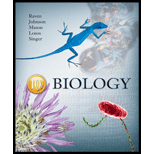
Concept explainers
In prokaryotes, control of gene expression usually occurs at the
a. splicing of pre-mRNA into mature mRNA.
b. initiation of translation.
c. initiation of transcription.
d. All of the choices are correct.
Introduction:
The genes can be defined as the sequence of the nucleotides, which codes for the function in a genome. It could be DNA (deoxyribonucleic acid) or RNA (ribonucleic acid). There are certain genes which express continuously in all the cells, these are known as the housekeeping genes. The expression of other kinds of genes is regulated.
Answer to Problem 1U
Correct answer:
In prokaryotes, the expression of the gene is usually regulated at the initiation of transcription. Therefore, option c is correct.
Explanation of Solution
Reasons for the correct statement:
The regulation of the expression of the genes is regulated at different stages. The genetic information from the DNA is passed on to the
Option c is given as “initiation of transcription”.
As, “the regulation of the gene expression in prokaryotes occurs at the initiation of the transcription”, is the right answer.
Hence, option c is correct.
Reasons for the incorrect statements:
Option a is given as “splicing of pre-
The splicing is the process through which the heterogeneous or pre-
Option b is given as “initiation of translation”.
In some of the prokaryotes, the control of the gene expression occurs at the initiation of the translation; however, it is not very common. So, it is a wrong answer.
Option d is given as “all of the choices are correct”.
The splicing is not the regulatory mechanism and the regulation at the initiation of the translation occurs in some genes. So, it is a wrong answer.
Hence, the options a, b, and d are incorrect.
The regulation of the gene takes place at the level of initiation of transcription mostly. This kind of regulation is the most studied. The regulation of the gene allows the differential expression of the proteins.
Want to see more full solutions like this?
Chapter 16 Solutions
Biology
- What symbolic and cultural behaviors are evident in the archaeological record and associated with Neandertals and anatomically modern humans in Europe beginning around 35,000 yBP (during the Upper Paleolithic)?arrow_forwardDescribe three cranial and postcranial features of Neanderthals skeletons that are likely adaptation to the cold climates of Upper Pleistocene Europe and explain how they are adaptations to a cold climate.arrow_forwardBiology Questionarrow_forward
- ✓ Details Draw a protein that is embedded in a membrane (a transmembrane protein), label the lipid bilayer and the protein. Identify the areas of the lipid bilayer that are hydrophobic and hydrophilic. Draw a membrane with two transporters: a proton pump transporter that uses ATP to generate a proton gradient, and a second transporter that moves glucose by secondary active transport (cartoon-like is ok). It will be important to show protons moving in the correct direction, and that the transporter that is powered by secondary active transport is logically related to the proton pump.arrow_forwarddrawing chemical structure of ATP. please draw in and label whats asked. Thank you.arrow_forwardOutline the negative feedback loop that allows us to maintain a healthy water concentration in our blood. You may use diagram if you wisharrow_forward
- Give examples of fat soluble and non-fat soluble hormonesarrow_forwardJust click view full document and register so you can see the whole document. how do i access this. following from the previous question; https://www.bartleby.com/questions-and-answers/hi-hi-with-this-unit-assessment-psy4406-tp4-report-assessment-material-case-stydu-ms-alecia-moore.-o/5e09906a-5101-4297-a8f7-49449b0bb5a7. on Google this image comes up and i have signed/ payed for the service and unable to access the full document. are you able to copy and past to this response. please see the screenshot from google page. unfortunality its not allowing me attch the image can you please show me the mathmetic calculation/ workout for the reult sectionarrow_forwardIn tabular form, differentiate between reversible and irreversible cell injury.arrow_forward

 Concepts of BiologyBiologyISBN:9781938168116Author:Samantha Fowler, Rebecca Roush, James WisePublisher:OpenStax College
Concepts of BiologyBiologyISBN:9781938168116Author:Samantha Fowler, Rebecca Roush, James WisePublisher:OpenStax College Human Heredity: Principles and Issues (MindTap Co...BiologyISBN:9781305251052Author:Michael CummingsPublisher:Cengage Learning
Human Heredity: Principles and Issues (MindTap Co...BiologyISBN:9781305251052Author:Michael CummingsPublisher:Cengage Learning Biology (MindTap Course List)BiologyISBN:9781337392938Author:Eldra Solomon, Charles Martin, Diana W. Martin, Linda R. BergPublisher:Cengage Learning
Biology (MindTap Course List)BiologyISBN:9781337392938Author:Eldra Solomon, Charles Martin, Diana W. Martin, Linda R. BergPublisher:Cengage Learning Human Biology (MindTap Course List)BiologyISBN:9781305112100Author:Cecie Starr, Beverly McMillanPublisher:Cengage Learning
Human Biology (MindTap Course List)BiologyISBN:9781305112100Author:Cecie Starr, Beverly McMillanPublisher:Cengage Learning Biology: The Dynamic Science (MindTap Course List)BiologyISBN:9781305389892Author:Peter J. Russell, Paul E. Hertz, Beverly McMillanPublisher:Cengage Learning
Biology: The Dynamic Science (MindTap Course List)BiologyISBN:9781305389892Author:Peter J. Russell, Paul E. Hertz, Beverly McMillanPublisher:Cengage Learning





